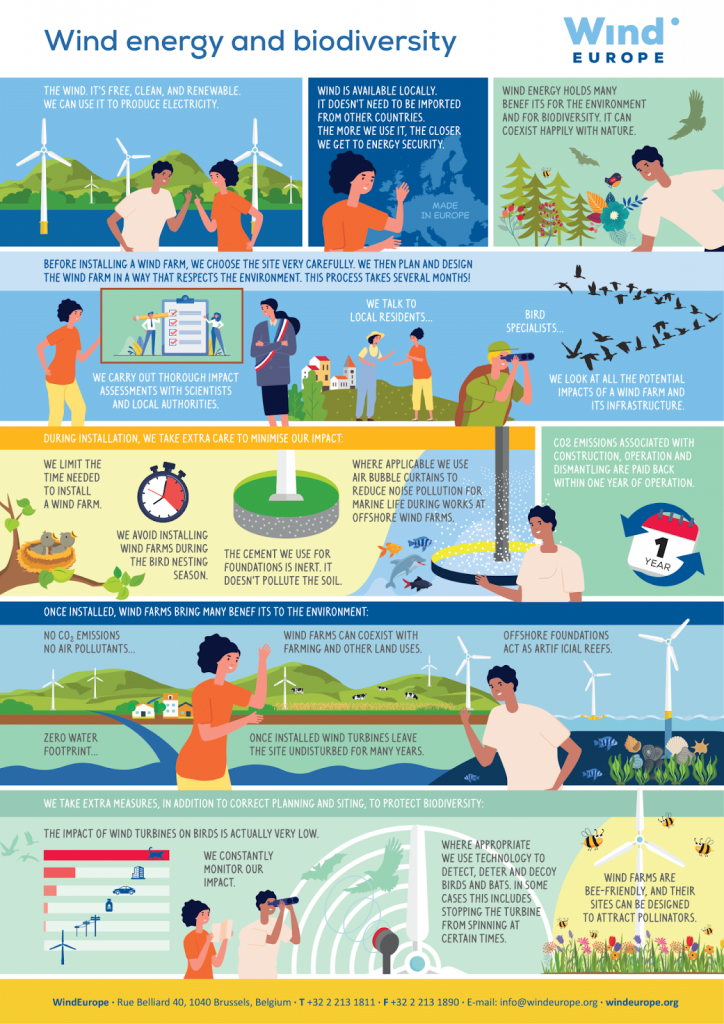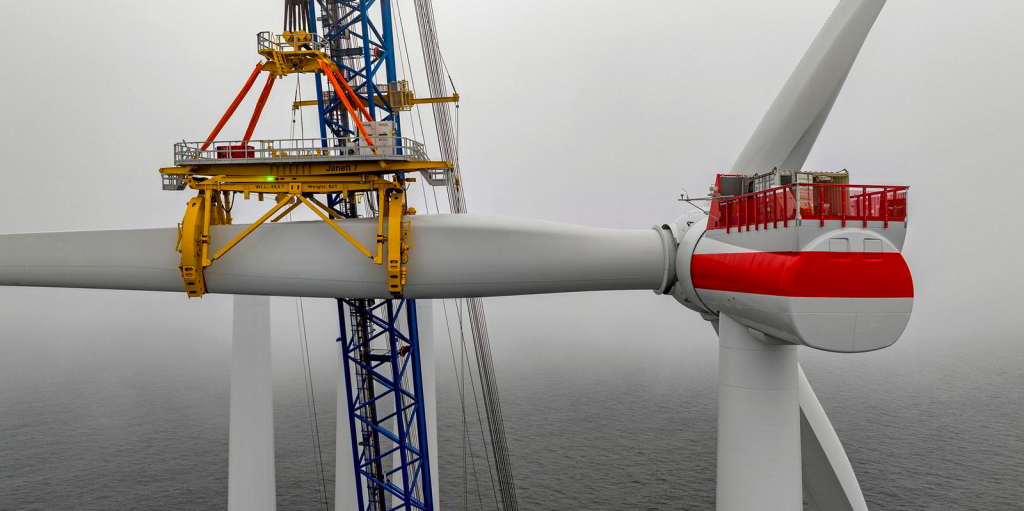Turbine Inspections
Wind Turbine Sizes
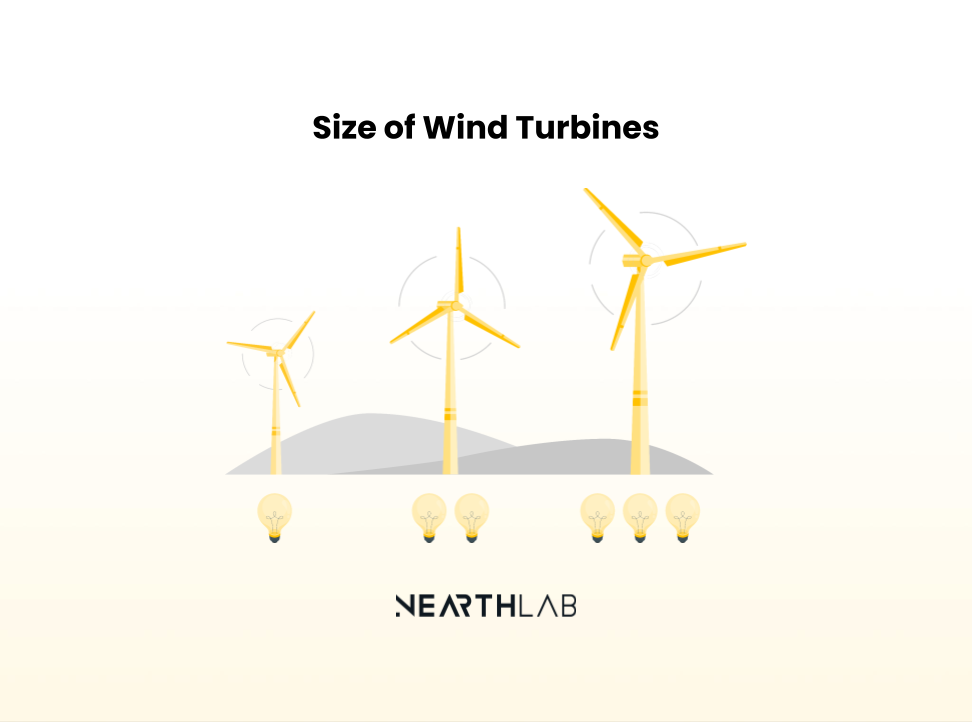
Progress in the renewable energy sector is often measured in leaps and bounds, and the wind industry is no exception.
In recent years, there has been a monumental shift toward embracing the era of supersized wind turbines.
But why go big? Isn’t bigger synonymous with more expensive?
Let’s unravel the mysteries behind the meteoric rise of these colossal structures and explore why bigger might just be better.
Why Go Big?
The logic behind building ever-larger wind turbines is rather straightforward.
Larger blades mean more wind capture, resulting in a substantial increase in electricity generation.
Consider these numbers: while typical onshore turbines with an average rotor diameter of 430 feet produce around 1.5 MW, GE Haliade X, with an impressive 722 feet rotor (nearly double the height of the tower Big Ben sits on), can produce a staggering 15 MW.
Putting up a handful of larger turbines has also proven to be much more efficient than flooding the landscape with smaller ones. Doing so not only saves space but also marks down material usage and maintenance costs, leading to higher returns on investment.
Scaling New Heights
The question then arises: how do you elevate these turbines to such heights?
- Expanding the Rotor Blades. By scaling up blade size, turbines can cast a wider net, capturing more wind energy across a vast area.
- Elevating to Higher Altitudes. By hoisting the rotors to greater heights with the help of taller towers, where the wind blows consistently and with more force, wind turbine blades can operate at peak performance.
The Grand Challenge
While bigger the better certainly seems to be the mantra in wind turbine design, engineering taller turbines with expansive blades is no easy feat.
Beyond technical challenges, there are non-technical limitations such as bottlenecks in transportation, infrastructure concerns, worries over land use, obstructed views, and potential impacts on avian life.
The very scale that makes these turbines formidable also brings its own set of challenges.
Solution: Offshore Wind Turbines
The solution to these challenges comes in the form of offshore wind turbines.
The boundless expanse of the ocean provides an opportunity to overcome constraints inherent in land-based alternatives. A prime example of this is GE Renewable Energy’s commitment of $400 million to develop the Haliade-X.
Standing as the largest, tallest, and most potent commercially available wind turbine to date, Haliade-X charts new frontiers in both efficiency and sustainability.
How High Can It Go?
In theory, the sky is the limit when it comes to the height of wind turbines. However, reality interjects with its own set of challenges that demand careful consideration.
Balancing Act
A looming concern is the erosion of turbine blades. Engaged in constant battle against raindrops and sea spray, the speed of the blade tips must be capped at 200 mph to thwart accelerated erosion. This limitation means that, as turbines grow larger and blades extend further, their rotors must spin at a slower rate to prevent wear and tear.
The Domino Effect
Slowing down the rotor to counteract high wind speeds triggers a domino effect. To maintain power output, the blades must deflect the wind to a greater extent, placing additional strain on other wind turbine components.
While expanding the surface swept by the rotor could be a potential solution, it brings its own challenges. Larger designs become progressively heavier, and the increasing blade length leads to higher manufacturing costs. At a certain point, the extra cost starts to outweigh the additional electricity generated.
Longer blades introduce yet another challenge — an increased susceptibility to bending. This complicates the task of maintaining complete control over the aerodynamics of wind flow and ensuring that the blades do not collide with the turbine tower, particularly under extreme weather conditions.
Technological breakthroughs may eventually overcome these engineering challenges. Yet, logistics present an entirely different narrative. The transportation and assembly of these large turbines pose logistical hurdles that must be addressed. Specifically, shipping Big Ben-sized blades in one piece demands vast ports, giant vessels, and offshore cranes capable of safe and reliable operation.
Nurturing the Future of Wind Power
As turbines reach unprecedented heights, an uncomfortable truth rises to the surface — no matter their towering stature or prolific output, the true potential of a turbine remains untapped if not meticulously maintained.
Regular, detailed inspections are the linchpin of a robust Operations and Maintenance (O&M) strategy, ensuring these colossal structures fulfill their maximal lifespan, consistently churning out cost-effective electricity.
In facing the challenge of these soaring giants, autonomous drone inspections have become an indispensable protocol in the maintenance playbook. But the story doesn’t end there.
To handle the vast amounts of data generated during inspections, intelligent analytics capabilities are imperative. Relying on antiquated methods to manage the expanding fleets is simply unsustainable.
Enter Nearthlab, a pioneering force offering a comprehensive suite of solutions designed to streamline the entire O&M process.
From NearthWIND Pro and Mobile, seamlessly conducting autonomous blade inspections even in the harshest offshore conditions within 15 minutes, to our cutting-edge analytics platform, Zoomable. The platform not only processes and identifies defects with pinpoint accuracy but compiles them into meticulously crafted reports at a moment’s notice.
Eager to explore ways to effortlessly manage your fleets? Click the button below and let us demonstrate how Nearthlab can propel your endeavors to new heights.
Turbine Inspections
Wind Electricity Generation: Breakdown of Seven Leading Countries
The cumulative electricity generated by wind has soared to 2,100 terawatts per hour (TWh). With that, wind power has effectively cemented its foothold as the frontrunner in the race toward net zero, second only to the mighty hydropower.
Bear in mind, though. Such a feat is far from the result of a collective global effort where each country has contributed equally. Rather, the landscape of global wind energy is a patchwork of contributions, with select few producers dominating the scene.
To that end, seven largest producers account for more than three-quarters of global wind power capacity. Notably, two powerhouses, China and the United States, command over half the capacity.
Wind Power by Country
Let’s delve into a detailed breakdown of wind power production, unveiling the distinct roles these countries play in shaping the future of clean energy.
China (278 GW)
China asserts itself as a formidable presence in the realm of renewable energy.
As the proud host of the world’s largest onshore wind farm, China doesn’t hold back when it comes to investing billions of dollars each year to erect and sustain wind turbines that dot its vast landscape.
The wind energy revolution doesn’t stop on land; it extends far beyond the shoreline. With 26 GW of offshore wind energy installed, China leads the way both on terra firma and over the open waters.
United States (146 GW)
Closing in on the heels of the People’s Republic is the States, a formidable contender in the race toward clean energy transition.
Within the 50 states, Texas emerges as the frontrunner, with Iowa, Missouri, and Wyoming hot on its tails, vying for a piece of the wind energy pie.
While the United States primarily harnesses the wind’s power through onshore wind farms, clean energy bills like the Inflation Reduction Act have set the stage for a dramatic shift.
Namely, in the coming decades, offshore wind generation is projected to play a pivotal role, potentially addressing up to a quarter of the nation’s energy needs.
The winds of change are blowing strong across the Land of Liberty.
Germany (66 GW)
Germany, with its abundance of engineering prowess, stands tall as the leading wind energy producer in all of Europe.
The strong presence of wind energy in Germany is partly a result of robust governmental support. With a steadfast policy aimed at producing all its electricity from carbon-free sources by 2035, Germany is on a journey to generate a grand total of 140 GW through wind power, with a split between 110 GW onshore and 30 GW offshore.
India (44 GW)
When it comes to generating energy, landmass plays a pivotal role. The more real estate to work with, the greater the potential for energy production.
That said, India secures its place as the fourth-largest wind energy producer on our list. The country boasts ample space to accommodate the vastness of wind energy infrastructure. It’s also worth noting that India is home to the third and fourth largest onshore wind farms in the world.
The only hurdle in India’s wind energy journey has been its limited offshore capacity. But such challenge too remains a matter of time, particularly with the government getting ready to roll out a series of offshore projects. With ambitious plans to develop 30 GW of installed capacity over the coming decade, India’s future in wind energy looks brighter than ever.
Spain (28 GW)
The numbers pretty much speak for themselves – over 2,000 turbines spread across about 1,000 wind farms dot the Spanish landscape. These figures paint a clear picture as to how one-fifth of the country’s electricity stems from wind.
What makes this even more impressive is that Spain isn’t renowned for having the sturdiest of economies yet stands as a shining example of wind power generation.
Similar to India, Spain relies entirely on onshore wind power. However, under the leadership of Iberdrola, it’s gearing up to develop commercial-scale offshore wind farms along its coasts.
Brazil (21 GW)
When we think of Latin America, renewable energy might not be the first thing that springs to mind. It’s not a dig at our friends south of the equator. They’ve just got their hands full with other pressing issues – think extreme poverty and that pesky corruption thing. Clean energy is a noble goal, but there are bigger fish to fry, right?
Well, surprise, surprise. One of the contenders for the top five spots on the list is none other than Brazil. This powerhouse has been making waves on the energy scene, and the same holds true for wind power.
Brazil’s wind energy potential is like a hidden gem waiting to shine. They’ve got ambitious plans to roll out over 100 GW of offshore wind capacity in the coming decade.
In a region where clean energy isn’t always the immediate headliner, Brazil is stepping up to the stage, ready to steal the show.
United Kingdom (21 GW)
The U.K. has a knack for making the most of its maritime resources. And we aren’t talking about their world-renowned fish & chips (although they’ve certainly nailed that too). No, we’re talking about the high seas of offshore wind where the Brits have set sail into uncharted waters.
Take the Dogger Bank, for instance, which is slated to become the biggest wind farm on the planet, as if they aren’t already home to large-scale offshore farms like Hornsea 2.
All this maritime effort adds up to nearly 13 GW of generation capacity, contributing to more than half of the country’s wind power generation. With renewable power technologies evolving at breakneck speed, the British wind market is set to expand at an even greater rate.
Pioneering The Future of Wind Energy
From the vast stretches of China to the expansive dreams of Brazil, these countries are rewriting the proverbial energy rulebook.
As we gaze into the horizon of change, there’s a crucial element taking center stage in this unfolding narrative – innovation. And leading this charge is none other than Nearthlab.
But don’t mistake us for just another drone solutions provider. Our proprietary drone has traversed the world, reshaping the landscape of wind operations and maintenance (O&M). We’ve ventured into the remotest of regions, where the concept of autonomous drone inspections is just beginning to take root.
While China remains an untapped frontier for us admittedly, we stand ready to extend our footprint to every corner of the globe.
As the world continues to embrace the power of the wind for a greener future, Nearthlab stands as a steadfast reminder of the boundless possibilities that lie ahead.
If you’re curious about how we can partner with you to achieve your energy goals, don’t hesitate to reach out by clicking the button below. Let’s ride the winds of change together!
Data AnalyticsTurbine Inspections
Standards Upon Which Blade Defects Are to be Categorized
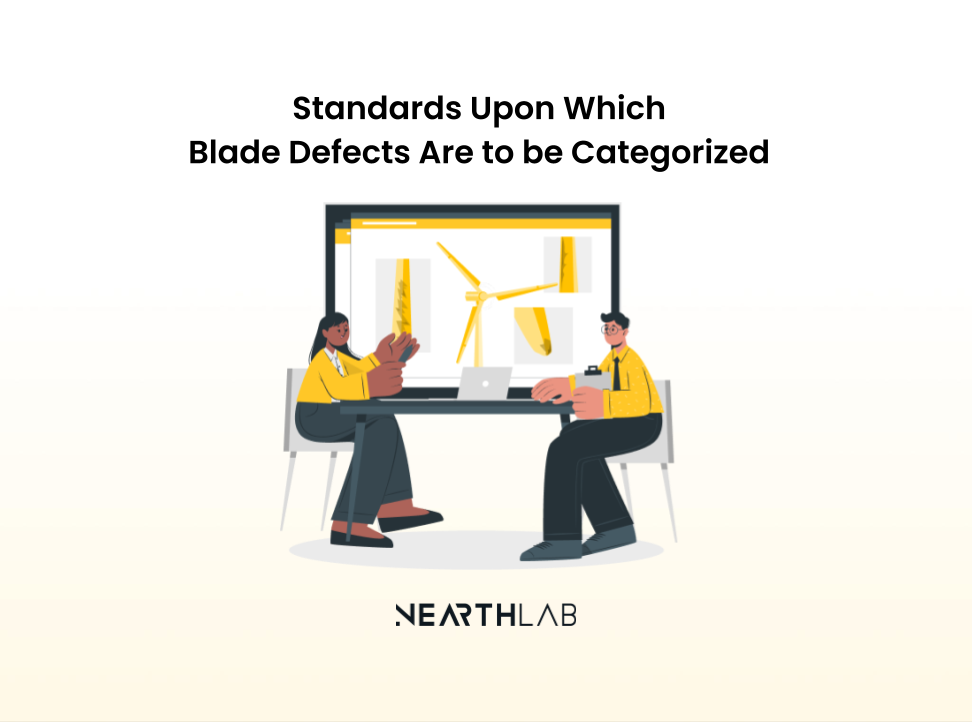
Wind power has blasted to the front of the pack in the race toward a sustainable future. Behind its rapid rise are unsung heroes in rotor blades.
Spinning tirelessly atop majestic wind farms, these colossal yet delicate fiberglass composites battle through repetitive fatigue loads and harsh weather conditions each passing day just to bear the fruits of clean electricity we need to jumpstart the energy transition.
In paying homage to their noble sacrifice, here we embark on a journey to explore the world of blade defects, shedding light on a list of categories into which they fall.
Present State of Affairs
Unless you didn’t know already, the wind industry is yet to see universal standards by which defects are sorted.
There have been attempts to put forward industry-wide categories but to little avail. The reasons are twofold.
First off, the discrepancy between actual and expected wind loads. Blades are designed with maximum pressure in mind. But certain areas may present lower resistance than expected, leaving room for what would’ve downright been a critical defect at sites facing higher velocity to be less of a deal.
Along with wind loads, inconsistency across the supply chain is also in play. Even if suppliers were to work with identical designs and tolerance limits, there’s no viable way to get every production facility to operate under the same manufacturing parameters, such as relative humidity, temperature, and vacuum pressure. These subtle yet distinct contrasts are bound to add up to make notable variations across material properties, which play a big part as to how a blade reacts to changes in surrounding factors and aerodynamic pressure.
New Era of Defect Categorization as Powered by Nearthlab
Case in point – coming up with reasonable standards that can drum up approval from wind farms of all stripes is a tall order. Hence the reason why we, with all humility, take much joy and pride in our latest achievement.
The categories we’re about to list out are a culmination of a decade-long track record of having analyzed a trillion gigabytes worth of post-inspection images. In the process, we’ve helped wind farms around the world – onshore and offshore alike – get the most out of their O&M budgets by setting forth clear-cut benchmarks for making out which defects deserve immediate attention and, vice-versa, which ones don’t.
Before we get down to the sweet science of categorization, let’s quickly brush over the types of damage found across the blades.
- Surface. Standing tall amidst open landscapes and the vast blue ocean, the surface serves as a frontline defense against nature’s wrath. Braving rain, hail, and the full heat of the sun, every day remains yet another battle against wear and tear for the coating, tape, and paint encasing the blades.
- Structural. Beneath the sleek exterior belies the brittle core. Once the surface falls and the shell is exposed, that’s when things start spiraling out of control. Chips, cracks, and erosion on the laminate and bonding must be tended to in due course, if not right away.
- Add-on. Blades these days are equipped with accessory devices that function as a buffer against devastating extraneous circumstances like lightning. Keeping them in working order isn’t to be taken lightly.
Categories Explained
Now, onto the nuts and bolts. Treating the defect types above as guidelines, we’ve compiled the following categories in ascending order of severity.
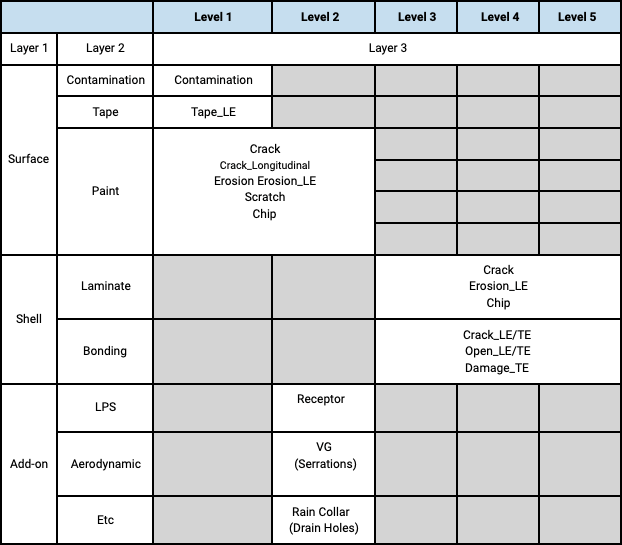
Severity 1
- Surface (coating/paint/tape) discoloration, flaking, and contamination (dust, wet spots, insect debris)
- Surface (coating/paint) damage (chip, crack, erosion, scratch, etc.), excluding laminate exposure
Severity 2
- Surface (coating/paint) damage (e.g., chip, crack, erosion, scratch, etc.), including laminate exposure
- Damages to add-on accessories (LPS, VG, rain collar, drain holes, etc.)
Severity 3
- Low-grade damage (chip, crack, erosion) to the laminate and juncture connecting leading and trailing edges (bonding)
- Laminate crack (~200mm and under)
- Bonding crack (~500mm and under)
Severity 4
- Acute damage (chip, crack, erosion) to the laminate and bonding
- Laminate crack (over 200mm)
- Bonding crack (over ~500mm and under 1000mm)
- Bonding open (under ~100mm in size and spotted within a five-meter range from the tip)
- Bonding open (under ~ 200mm and spotted outside of beyond, a five-meter range from the tip)
Severity 5
- Critical damage (chip, crack, erosion) to the laminate and juncture connecting the bonding
- Splitting of the shell from laminate crack (all shapes and sizes)
- Bonding crack (1000mm and over)
- Laminate/Bonding open (over ~100mm in size and spotted within a five-meter range from the tip)
- Laminate/Bonding open (over ~200mm in size and spotted outside of a five-meter range from the tip)
- Buckling
Final Words
From tiny surface scratches and indiscernible dust stains to egregious rifts and thunderous lightning strikes that wreak havoc, each defect comes with its own set of challenges.
Through diligent inspections and prompt maintenance, as illustrated through NearthWIND Pro and Mobile, we’ve empowered blades to continue their noble mission of bringing a greener tomorrow. Now with detailed yet comprehensive standards under our belt, the future of blade O&M will come to shine brighter than ever.
Looking to get a feel of how defect categories will come to revolutionize your O&M game? Connect with one of our specialists today to get on Zoomable for a firsthand experience.
Turbine Inspections
Wind Turbine Maintenance Made Easy
The appetite for wind energy is greater than ever. Still yet, developers are hardly getting much out of the boom.
How come? Think maintenance.
Bear in Mind
Behind every sustainable initiative is a return on investment (ROI). The same goes for wind farms, to which turbines are a vehicle not just to jumpstart the energy transition but shore up their bottom lines.
The problem with that is financial projections are generally set assuming the assets would see through their designated lifespan operating at optimal capacity. Sadly, such is seldom the case.
Where Your Maintenance Efforts Stand
Full-on breakdowns are few and far between. In fact, most modern-day turbines make it to the final days of their operational lives – around two or three decades, give or take – before getting decommissioned.
That’s to say longevity doesn’t necessarily make up for a reliable barometer to gauge the consequences of proper or, by that token, inadequate maintenance. In this very instance, you might want to look at unintended curtailment instead.
Let’s Talk Curtailment
Barring extraordinary circumstances in which blades are deliberately feathered to prevent power outages from feeding the transmission grid too much energy, curtailment manifests in the form of aerodynamic drag and prolonged downtime, two of which go hand in hand.
Here’s what we mean.
A wind turbine is comprised of three major parts – the nacelle, tower, and rotor comprising three blades attached to a hub.
Now, let’s say a tiny crack on the leading edge goes unnoticed. The lift-to-drag ratio starts to slip as the blade slowly loses the ability to capture the wind. Worse yet, the rest of the turbine is left to bear the brunt of excess fatigue loads, exposing both the nacelle and tower to rifts.
What does all this amount to? Extensive downtime during which the turbine can generate several thousand dollars worth of energy.
Maintenance Planning Checklist
The sheer magnitude of lost revenue is enough to zero in on maintenance. However, just as inadvisable is doing too much. Maintenance consists of cost-incurring activities. Overdoing it may end up dealing an unwanted blow to profit margins.
The key is to tread the fine line between too little and too much maintenance. Among others, how each wind farm goes about striking that balance depends on the following factors.
Data
The best maintenance is one in which the element of surprise is nowhere to be seen.
For that to be the case, operators must have a general sense of when and which component would give out so that they can address the issue at the outset or, better yet, before it breaks out. Doing so requires access to an extensive index of failure characteristics.
Unfortunately, industrial-scale deployment of wind energy is only about a couple of decades old, which, for the most part, isn’t enough time to put together a reliable, data-driven framework to base the predictions on.
If you happen to have enough operational data in the vault to work off of, kudos to you – predictive maintenance has just gotten a lot easier. Otherwise, start keeping close track of failures and repairs. Or else, maintenance will long remain a game of possibilities.
Need help figuring out where to start? Check out fleetMONITOR from ONYX Insight.
An advanced condition monitoring software platform built upon a vast diagnostics portfolio of over 14,000 turbines spanning 95 models across 23 manufacturers, tapping into fleetMONITOR will go so far as to feed you with detailed real-time reports on potential faults based on well-established historical data, opening up the doors to saving up to 30 percent on O&M costs while ramping up annual energy production by two percent.
Size
When it comes to mapping out maintenance strategies, size matters. And the general rule of thumb that rings true in most instances is larger the asset, the lower the operational cost.
The logic behind it is relatively straightforward:
Bigger turbines -> Higher yield -> Less number of turbines to hit the energy quota -> Fewer maintenance orders per megawatt (MW) of output
A unique context in which such a principle doesn’t necessarily hold up is offshore. Though farms over waters boast higher output, arranging maintenance tasks – getting the supplies and technicians to the site, working through logistical barriers, etc. – tend to be way more complicated and costly.
Average Cost
Life would be easier had there been a one-size-fits-all approach to calculating maintenance costs. Reality, however, seldom accommodates ideal circumstances, and the best we have is a ballpark estimate.
For older turbines, expect annual O&M charges to fall between three to five percent of the installation costs. The range drops to 1.5 to two percent for newer models, which amounts to about $42,000 to $48,000 per year.
Now, be aware. The suggested numbers here posit that the equipment in question is an average-sized onshore turbine with a production capacity of two to three MW. Precisely how much your final cost turns out to be will largely depend on, environmental factors, size, and site conditions.
Tools to Minimize Cost
Estimation is one thing; cost-cutting is another. Thankfully, when it comes to minimizing O&M expenditures, there is an all-encompassing solution well-suited for wind farms of all stripes.
Enter complete turbine maintenance.
From blade inspections and drivetrain integration to fault diagnosis and enterprise management, the suite of services borne out of the latest partnership between Nearthlab and ONYX Insight gives in-house teams all the tools to supercharge maintenance efforts – whether that’d be preemptively catching component failures, prioritizing repair tasks based on defect severity and budgetary confinements, putting together analytics reports, or just conducting due diligence.
Talk to one of our specialists to find out how we can help elevate your maintenance to new heights at a fraction of the cost.
Turbine Inspections
All Things Wind Turbine Blade Inspection
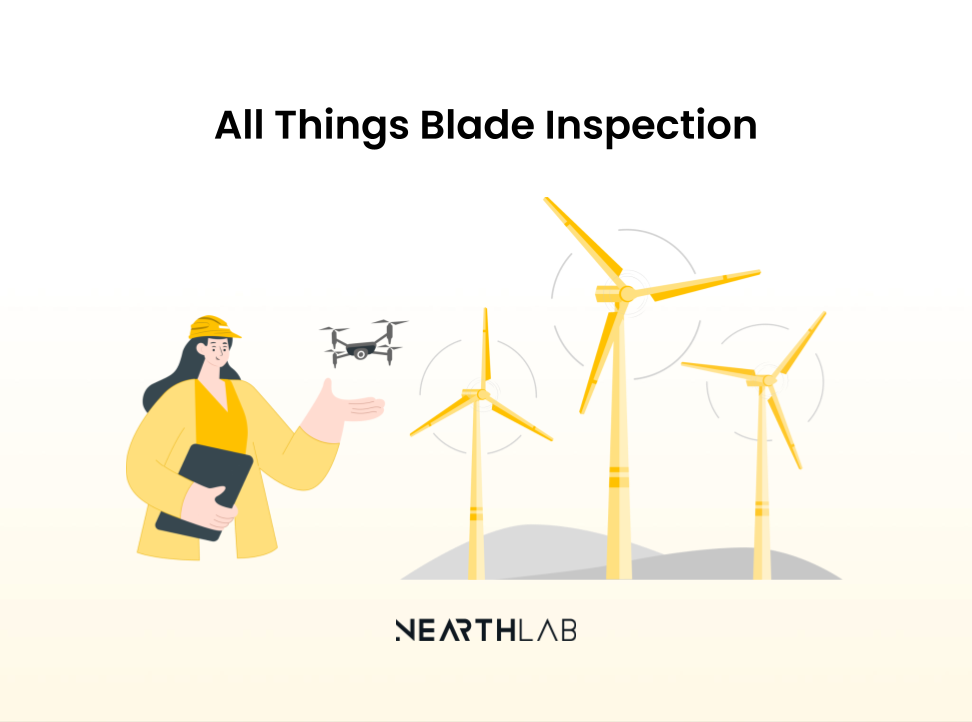
Tick-tock.
That’s the sound of your blades inching toward their final twirl.
Unfortunately, there’s no viable way to stop the clock. Slowing down the tick, though? That much is within our reach.
Timely Inspection is King
Aging doesn’t discriminate.
In the same way Father Time wears heavy on those who fall victim to complications, blades left without routine maintenance protocols bear the brunt of everyday wear and tear.
That’s not to say blade management has to be all doom and gloom. With the right tools that allow for timely inspections, making sure the blades see through the final days of their designated lifespan is very much attainable.
A Thing About Blades
What’s the big deal with blades when other components are just as exposed to surrounding factors and forces, you ask?
Well, for starters, no other parts of the turbine are in constant motion. Blades are unique in the sense that they experience repetitive fatigue loads amplified by turbulent wind flows.
Their unique material composition doesn’t help either. For maximal aerodynamic efficiency, blades are made with composite comprised predominantly of fiberglass, which is susceptible to delamination, erosion, and weather hazards like lightning and water ingress.
All this amounts to nearly 4,000 cases of blade failure reported each year. The actual number is likely to be higher, considering how companies prefer to keep such incidents under wraps to avoid attracting bad press.
Ways to Go About It
Now that we’ve gone over why blade inspections are a must, it’s time we got down to the how part.
Paradigm Shift
Wind farms have long relied on manual processes to look after the blades. And that’s not a knock on operators. There simply hadn’t been a viable alternative until the latter half of the past decade when authorities began relaxing regulations for drones to – no pun intended – spread their wings across industrial sectors.
Since then, the industry has seen an explosion in drone use. Though such a trend can be written off as a classic case of technology leapfrogging human capacity, the fast rise of drone inspections is a bit more nuanced than that.
Old School Approach
There are three ways to go about inspecting blades manually.
- Install scaffolding to get a close-up look.
- Scan the assets from the ground up using a high-resolution camera.
- Bring in rope access technicians and have them climb down all three blades one by one.
Had you been a site manager at an offshore wind farm, you’d be left with no choice but to work with rope access. The other two banks on the premise that there’d be solid grounds on which operations can be performed.
Things don’t get much better onshore. Only so much can lenses zoom in or, by that token, so high the structures can go.
Rope access also comes with its own set of risks. Namely, the entire operation hinges on the optical acuity of the technicians whose lives are hanging by a thread several stories above the ground.
The New Norm
It pays to get your hands dirty in certain cases. Wind turbine blade inspections just aren’t one of them.
While a team of dedicated specialists spends hours squinting and knocking, a drone – a highly autonomous one at that – takes about 15 minutes to collect hundreds of high-resolution images across all three blades.
The difference seems even more pronounced when numbers are taken into account. With the right solutions, wind farms can see up to a 70 and 90 percent drop in inspection and downtime costs, respectively.
Whether it’s for the sake of accuracy, efficiency, or safety, the reasons to tap into drone services are pretty much endless.
How Nearthlab Covers Every Inch of Wind Turbine Blades
Not all drone technology is created equal.
A certain degree of autonomy is required for the drone to provide consistent, reliable data. Otherwise, the success of each inspection would lean on the pilot who, depending on the day, might not show up at their best.
With NearthWIND Pro, that’s no longer a concern. Powered by computer vision and remote sensing models, Nearthlab’s drones fly along an optimal path finetuned through surface detection and object avoidance algorithms all by themselves, catching the tiniest of cracks and defects in an efficient and foolproof fashion.
Of course, not everyone has the wherewithal to pick up full-fledged inspections. That being the case, NearthWIND Mobile is at your service to turn any given off-the-shelf product into an autonomous inspection-ready drone. It’ll have you conduct spot checkups on the fly in no time.
Whichever you go about it, Zoomable will be there to take over once the entire process is done and dusted. After all, what good are streamlined inspections if you burn through days, if not weeks sorting through all that data? From pre and post-processing to defect detection and reporting automation, Zoomable will go the whole nine yards to automate your post-inspection analytics workflow.
Talk to one of our specialists to learn more about how Nearthlab can help make the most out of your inspection efforts.
Turbine Inspections
Offshore Wind and Environment Don’t Mix? Think Again

Offshore wind energy is taking off like never before. But not without opposition.
Advocacy and community groups have filed lawsuits against plans to build large-scale offshore farms on the grounds that pertinent agencies have failed to adequately assess the ramifications these projects may have on the environment.
Much to offshore developers’ delight, one of the cases has been tossed after months of legal tussle. While the rest gets sorted out, we wanted to get knee-deep in the issue to see what the actual science says about the ongoing strife over the ecological impacts of offshore wind.
Points of Concern
As we mentioned in our previous post, dotting the sea floor with gigantic steel girders has certain implications for marine mammals and their habitat.
But what exactly do such implications entail? The following are three major points of contention between offshore wind farms (OFWs) and activists.
Noise Pollution
The issue with sound can go both ways. Either the noise emitted during installation disrupts the way of underwater life, or the constant rotation of the blades keeps nearby residents up at night.
The latter is more so a matter of technicality as OFWs are seldom constructed in close vicinity to the coast for operational noise to breach municipal ordinances.
The former, however, pose a legitimate concern. Especially when the process involves drills and steel drivers, two of which together give out a noise loud enough to stress out marine species that rely on auditory modalities for communication and navigation.
Habitat Alteration
Drilling down steel piles stirs up a hefty amount of clay and silts. Then follows an uptick in the concentration level of suspended sediment, which brings down the quality and quantity of incident light, making things difficult for benthos and other bottom-dwelling organisms that gain energy from the sun to thrive.
Waste Management
The argument over waste management has lost its vigor now that there’s technology to take inert blades out of landfills and back into the environment. But the issue still carries some weight in offshore contexts where the average turbine size tends to be considerably larger.
Circles of Influence
Despite all this, the total installed capacity is projected to reach 630 gigawatts over the next three decades.
How is it possible for offshore wind to enjoy such explosive growth when challenges as complex are standing in the way?
The short answer is technology.
Sure, regulatory processes like those of marine spatial planning and strategic environmental assessments are there to lay the groundwork for offshore projects to be rolled out in the most eco-friendly way possible. The crux of the transformative force that turns offshore wind into a positive environmental factor, however, is technology.
Bubble Curtains
Chances are, you’ve seen a recording studio insulated by panels made up of porous foams. What those panels do is absorb the vibration, preventing sound waves from escaping the room.
Bubble curtains leverage that very principle but within an underwater context.
By releasing air bubbles through an oil-free compressor that rises to the surface and forms a whirlpool-like barrier, bubble curtains ramp up the density of surrounding water molecules to a point where sound waves from the installation are either broken down or significantly dampened before reaching outside the curtain wall.
A good use case that speaks to their effectiveness is the Wikinger project in which Spanish energy leader Iberdrola employed bubble curtains as the primary means of noise control, leaving a minimal ecological footprint in constructing a billion-dollar offshore wind farm.
Coral Restoration
“By installing offshore wind farms in a sedimentary environment where no solid substrate exists, we create a stable and long-term surface that corals can grow on. Then we can artificially intervene using the nature of these organisms themselves to help them grow in that location.” – Justin Hsieh, Director at Penghu Marine Biology Research Center
Bubble curtains zeros in on mitigation. The goal here is to minimize noise.
Coral restoration, on the other hand, is all about rehabilitation. It aims to reverse potential habitat loss by introducing lab-cultivated larvae right on the artificial substrate.
Spearheading this innovative approach is none other than Ørsted. The Danish energy giant has been unlocking the magic of coral restoration through ReCoral, which continues to diversify the range of habitats and boost biodiversity across offshore sites.
Recyclable Blades
The well-deserved hype behind ReCoral comes from the fact that it doesn’t just mitigate but improves existing circumstances. The same goes for recyclable blades.
All credit to Siemens Gamesa for bringing the concept of blade recyclability to fruition, what had once been deemed an environmental hazard is now being reproduced into cement, plastics, and other much-needed industrial materials.
Of course, recyclable or not, the best course of action would be to keep the blades out of landfills by maximizing their lifespan. To do so, you’ll need to keep close tabs on the status of the blades through timely and efficient inspections.
Looking after the blades, particularly at offshore sites, can be a handful. If you at all resonate, check out NearthWIND and NearthWIND Mobile, tried-and-true solutions tailor-crafted to turn blade inspections from a painstaking undertaking to a seamless and effortless process.
Final Verdict
Gut tells us that anything industrial can seldom be conducive to the environment. While that may be true for most industrial activities, it’s hard not to rule out offshore wind as an exception.
That’s not to say offshore wind comes free of environmental risks. But as we covered, there are tools in place to offset potential complications and even enrich the oceanic waters and their wonders.
As technology continues to mature and these tools deploy at a grander scale, the future of offshore wind will come to shine brighter than its past.
Turbine Inspections
Offshore Wind Energy: Powering the World From the Middle of the Ocean
Fast doesn’t always mean better. Well, in the case of wind energy, it kind of does.
That very principle goes to explain why offshore wind power is heralded as the next big thing in renewable energy. The entire concept by which offshore wind farms operate revolves around capitalizing on higher wind speeds over waters with larger turbines.
The result? Wind projects with nearly triple the output of onshore counterparts. To put into perspective, that amounts to roughly a million additional watts over the course of a year.
How Offshore Wind Farms Work
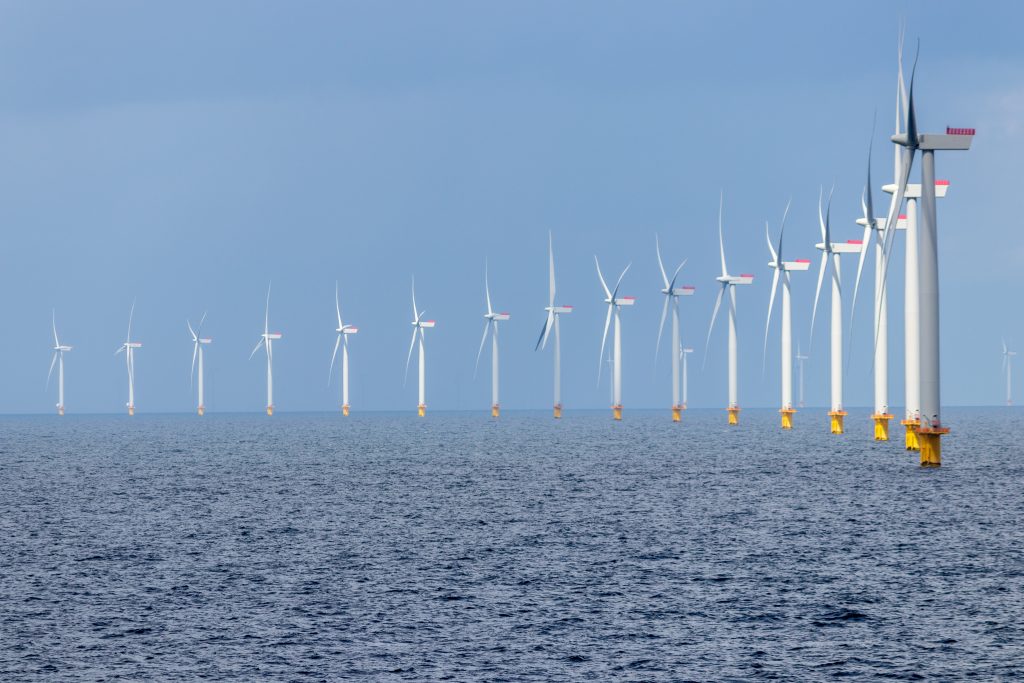
Just because there exists a wide gap in total installed capacity doesn’t mean offshore wind technology comes with some sort of a silver bullet. In fact, the way offshore wind turbines generate electricity is pretty much identical to how it’s done ashore.
Production
Here’s how any given turbine turns wind into electricity:
- Wind blows.
- Rotor blades, along with the drive shaft they’re connected to, spin.
- The gearbox ramps up the resulting rotation to over 100 times.
- The high-speed shaft takes the enhanced energy and passes it on to the generator, where kinetic energy is converted to electricity.
Distribution
Production is only half the story. The rest is getting that electricity delivered to homes and communities.
If anything, though, transmission is a relay, not a sprint. And it may take a little while until the electricity produced from the wind farm reaches your cozy abodes. It needs to make a couple of stops along the way.
- Initial Stop. The electrical energy flows to the offshore substation through the array cables linked to the turbine. There, a step-up transformer jacks up the voltage to prevent energy loss.
- Midway Stop. Through the undersea cables the electricity once again makes its way over to the onshore substation. Capacitor banks installed in the substation recorrect the voltage and the current to fit the grid requirements.
- Destination. Primed for distribution, the electricity is fed to the transmission grid for commercial and residential use.
Types of Offshore Wind Turbines
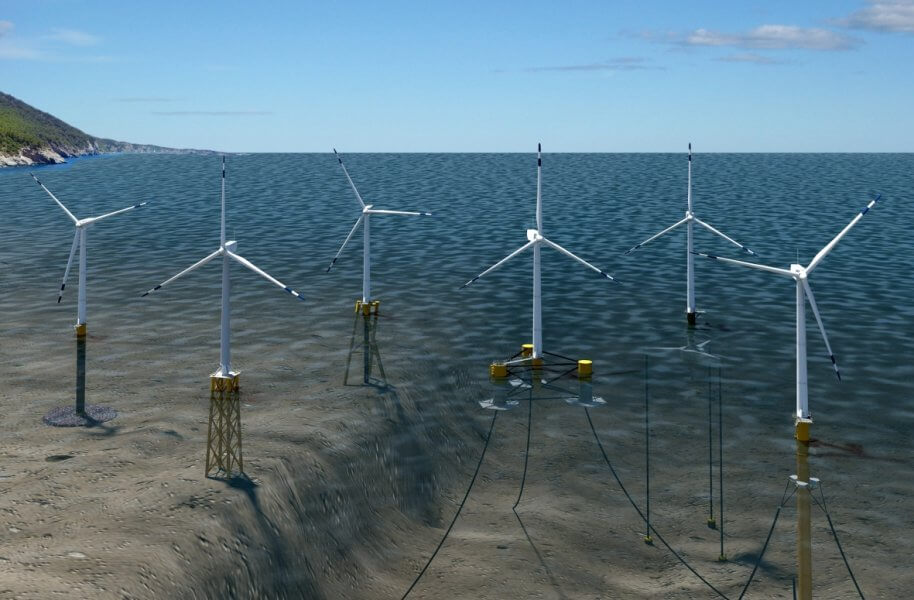
How long it takes to generate and transmit electricity depends on a few factors. Most obvious among them is distance – the farther off the coast, the longer the process. That much is a no-brainer.
What may not be so obvious is the fact that distance plays a critical role in how offshore turbines stay afloat.
Transitional and Shallow Waters
First things first. Let’s define deep.
Within the context of offshore wind power generation, anywhere above 300 feet is deemed deep. That’s also the extent to which the structural integrity of fixed foundations holds up.
The specific type of foundation depends mainly on depth and seabed conditions. The following is a rundown of four different shapes bottom-fixed turbines take.
- Gravity-Based (~100 ft). A massive piece of concrete or steel ballasted with stones and sediments. Sitting atop a layer of ready-prepared gravel, its sheer weight prevents the turbine from tipping over.
- Monopile (~115 ft). A giant steel nail drilled into a stiff, sandy ocean basin. The undisputed king of fixed foundations that account for 80 percent of all offshore support structures.
- Tripod (82~164 ft). Underneath the monopile-like surface lies a central tower supported by a three-legged frame driven into the seabed. Designed to withstand tidal currents powerful enough to erode the sediments holding the foundation in place.
- Jacket (165~260 ft). Think monkey bars designed for an offshore wind turbine. The lattice-truss structure allows for an even weight distribution, which translates to greater load-bearing capacity and allows for the turbine to stand firm against wave-induced vibrations.
Deep Waters
“Up to 80 percent of offshore wind resources globally are in deep waters where traditional bottom fixed installations are not suitable.” – Irene Rummelhoff, executive vice president at Equinor
As robust as they may be, fixed substructures don’t come cheap. And there comes a point where the cost of manufacturing bottom-fixed installations starts to outweigh the benefits an offshore wind farm can reap.
That’s why deeper waters have been off-limits for so long despite their immense production potential. The money that goes into mass-producing these mammoth pieces of steel hull is simply too much.
Thanks to offshore wind developers who racked their brains for a near decade to come up with a workaround, that’s no longer the case. The entire ocean is now our oyster with the rollout of commercial-scale floating platforms underway.
Now, just like bottom fixed installations, floating foundations can go four ways. Let’s take a closer look.
- Spar-Buoy. Real–life application of Archimedes’ principle in which buoyancy is achieved through displacing a mass of water by partially submerging a vertical cylinder. Kept in position using mooring lines or suction anchors.
- Semi-submersible platforms. Multi-legged cousin of spar foundations. Relies on relatively short-diameter columns and a mooring system for stability.
- Tensioned Legs Platform (TLP). Floater comprised of columns and pontoons. Locked in place with tensioned tendons that prevent vertical motion like heaving.
- Barge. Boat-like platform with a large, flat base. Generally towed to a designated spot with heave plates.
Offshore Wind Generation Benefits
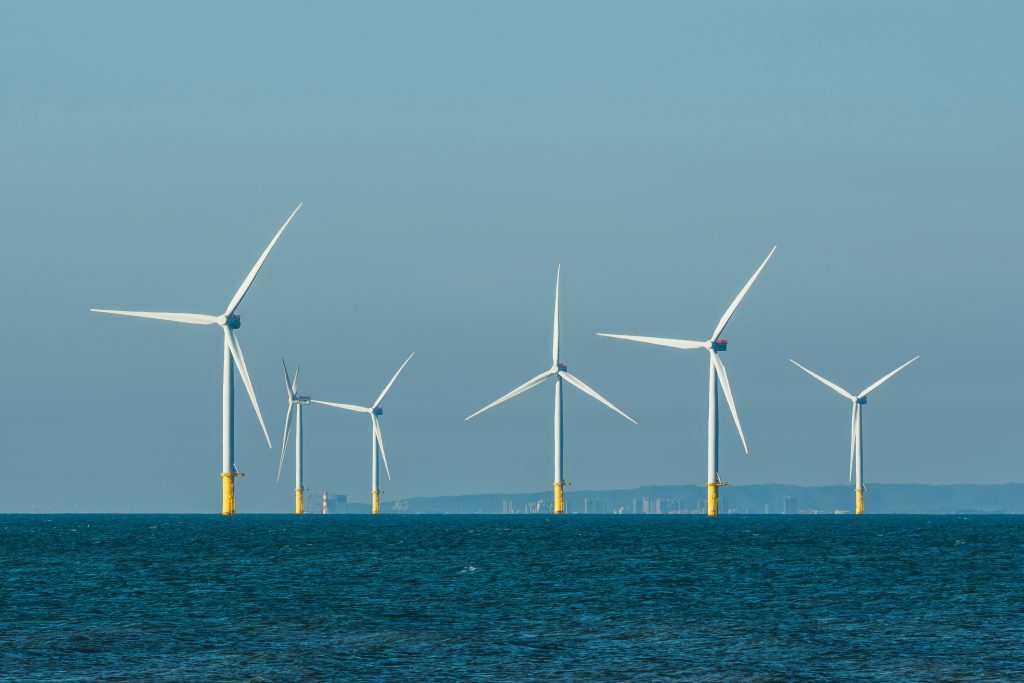
As new technologies continue to scale, offshore wind power capacity is slated to go from 40 gigawatts (GW) to a whopping 630 GW over the next three decades. Even among industries experiencing a double-digit increase, growth at such a breakneck pace is unheard of.
Being an inexhaustible yet explosive source of green energy, the mass appeal of offshore wind may seem almost self-explanatory. But there’s much more to offshore wind than just that.
The following are three major benefits offshore wind has to offer.
Production Capacity
All else equal, a wind speed of 15 mph generates twice as much electricity as 12 mph. As such, a seemingly minor increase in wind speed leads to a dramatic rise in energy production.
That’s to say seabased farms can churn out the same amount of energy onshore wind farms produce with fewer turbines when, ironically, there’s much wider space to install more over the waters.
Job Creation
To what end are governments around the world pumping millions of dollars into large-scale initiatives as that of the Inflation Reduction Act? To incentivize the use of alternative energy other than fossil fuels in an effort to reduce greenhouse gases?
On the surface, perhaps so. But just as vital is the economic incentive, which comes in the form of job creation.
Keep in mind that manufacturing, installing, and maintaining offshore wind turbines are complex maneuvers that draw from a concerted effort by multiple supply chains and verticals. And as offshore wind kicks into higher gear, the demand for jobs across engineering, maritime trade, finance, and other corresponding fields will grow proportionally.
Talking numbers, the offshore wind industry in the U.S. alone is expected to post up to 58,000 additional jobs annually for the next seven years.
Community Revitalization
Robust job growth alone isn’t enough to infuse communities with newfound vitality. But once new facilities are up and running? Now, that’s a different story.
Notably, when these facilities start working with local suppliers and businesses, it’s only a matter of time before the neighborhood becomes a manufacturing hub.
As regards to coastal towns heavily reliant on the tourism economy, the chain of events depicted here is beyond favorable.
Give the following case studies from American Clean Power Association and Orsted a read to get a detailed look into the process by which offshore wind brings new prospects and opportunities across coastal communities.
Environmental Impacts
One doesn’t need to be a wildlife biologist to suppose that dotting the sea floor with gigantic steel girders would carry some sort of implications for marine mammals and their habitat.
While much of its environmental impact is yet to be explored, research suggests that offshore wind’s effect on biodiversity should be considered net positive, not the other way around.
The reasons are threefold.
- Rigorous Preliminary Screening. Offshore installations don’t happen overnight. Detailed studies must be conducted years in advance under the guidance of the Environmental Protection Agency (EPA) to assess the compatibility of the site with maritime uses. Only after dotting all the i’s and crossing all the t’s follows the go sign to move forward.
- Buffer Technologies. From Iberdrola‘s noise mitigation solution to Orsted’s coral restoration project, the industry is seeing the emergence of cutting-edge technologies designed to accommodate the symbiosis between marine life and wind farms.
- Climate Change Mitigation. It’s no secret that rising temperatures impose irreversible damage to marine ecosystems. By mitigating carbon emissions and stabilizing the climate, offshore wind power can expedite the much-needed restoration of marine life.
Making the Most Out of Offshore Wind Projects
If there’s any downside, it’s that offshore wind can turn out to be relatively high maintenance. Particularly since offshore wind turbine components are exposed to high winds and sea waves, the need for consistent, proper care tends to be more pronounced than land-based counterparts.
Though fantastic in their own right, inspection solutions using industrial-grade drones come with all sorts of logistical complications that throw routine maintenance out of the question.
With a plug-and-play solution that delivers quality inspections with commercial off-the-shelf drones, however, it’s a whole ‘nother ballgame. Give NearthWIND Mobile a go and let the magic of spot checkups unlock the potential of your offshore initiatives.
Turbine Inspections
Complete Guide to Wind Turbine Inspection
The world is home to over 341,000 turbines.
Now, let’s do a little math. Manual means, be it ground-based monitoring or rope-access operation, take more or less six hours to look over a turbine. Given that they’re done no more than twice a year, how many hours go into inspections for an average wind farm?
A whopping 4.1 million hours. We’re talking about 467 years of downtime, all without taking into account change orders, weather-related delays, and other externalities that may as well drag out the process for another couple of decades.
Why Put Up With the Hassle?
As a matter of fact, inspections don’t have to be a hassle. More on that later.
For now, we get it. Standing taller than the pyramid at 466 feet with an average wingspan of 418 feet, it’s almost counterintuitive to think that a mammoth piece of steel as that of a wind turbine would need to be looked at more than once or twice a year.
Don’t let the looks fool you, though. Turbines happen to be deceivingly fragile creatures despite their monstrous presence. Particularly for rotor blades made of fiberglass, a seemingly negligible surface rust on the leading edge can lead to a dramatic loss in energy production.
This is all to say that keeping tabs on turbine status is of paramount importance. Preventing everyday wear and tear from brewing into bigger problems is vital for optimal performance and a viable lifespan.
Evolution of Turbine Inspections
There are two ways to go about manually inspecting a turbine.
Rope Access Operation
A typical rope access operation is carried out in three strokes.
- The rotors come to a standstill, with the lowermost wind turbine blade pointing straight down at a six o’clock position.
- A group of three or more technicians ladders up the tower.
- Tethered to a rope secured to an anchor point, inspectors make their way down from the nose cone, looking for damages.
The most obvious catch here is the looming possibility of fatal consequences. One stiff breeze and the rope gets in the way of the trailing edge of the blade, that’d mark the beginning of an end to an irreversible tragedy.
Technicians themselves know full well what they’re getting into. If anything, the insurance fees listed below steep service charges and miscellaneous expenses should speak to how uber-aware they’re of such risks.
Ground-Based Monitoring
Looking at a turbine through the lens of a high-resolution camera from the ground is one of the safest inspection methods out there. Yet there’s a reason why most wind farms rely on rope access to look after their assets.
Consider this for a moment. Even with the most advanced full-frame cameras, it takes a slew of snaps from different angles and ranges to capture a clean portrait. Well, good luck catching millimeter-sized cracks 200-plus feet above the ground.
Case in point: ground-based methods tend to be ridden with bad data. After all, what good is an inspection if much of the images collected during the process turns out to be moot?
Drone Wind Turbine Inspections
Leaving defect detection and preventive maintenance under the purview of traditional inspection techniques is dicey at best.
But every cloud has a silver lining. Casting a slither of light across the bleak picture painted by drawn-out manual processes is none other than uncrewed aerial vehicles (UAVs). Inspections have turned the corner since these little robotic aircraft entered the scene.
To put things into perspective, tapping into autonomous drone solutions can lead to a 70 and 90 percent drop in inspection and downtime costs, respectively.
And that’s just a fraction of what they have to offer. Wind turbine inspection drones are like a gift that keeps on giving.
Routine Inspections
Just because wind farms are devoted to the cause of sustainable energy production doesn’t mean they operate out of sheer goodwill. At the end of the day, it’s the figures on the books that keep the turbines spinning, not altruistic motives.
By that token, every second the turbines stay still is a financial toll. Rack up hours of downtime that snowball into days, weeks, and eventually a month; the amount of lost revenue from inspections can turn out to be crippling. Hence the reason why most wind farms determine against giving their assets a look more than twice a year.
With drones, however, that’s no longer the case.
Not only does UAV inspection come at a fraction of the cost, but topline solutions such as NearthWIND Pro take no more than 15 minutes to inspect all three blades – a task that could eat up the whole day for a three-man squad of the most qualified rope access specialists.
To top it off, a select few service providers offer technology specifically designed for spot inspections. Perhaps the most well-established among them is NearthWIND Mobile, an award-winning plug-and-play solution that turns off-the-shelf products into autonomous inspection drones tethered to a smartphone.
By harnessing the power of drone solutions that give way to cost-efficient, hassle-free checkups, wind farms will have plenty of uptime to fit in additional rounds of inspections without letting downtime costs spiral out of control.
Diagnostic Imaging
Imagine going into an annual physical only to come out after getting a cursory examination of your general appearance. Ludicrous, right? As if there isn’t so much more to health than looking fit.
The same goes for wind turbine components. Just because they appear defect-free doesn’t mean everything is sunshine and roses underneath. The only way to gauge the true status of the assets is by factoring in the sanctity of the internal structure.
Unlike its exterior counterpart, drones and humans aren’t the only primary means available. Wheeled crawlers and hyperthin fiberscopes also make up the pool of potential inspection methods. While the two are worthy of consideration, keep in mind that both are bound by spatial limitations.
That’s what seems to give drones the edge when it comes to internal inspections. Equipped with infrared cameras or ultrasonic payload, drones can identify irregularities below the surface with laser-sharp precision across areas that neither humans, cable cameras, nor robotic crawlers can see nor access.
As another food for thought, the law prohibits an inspector from traversing past 91 feet. That leaves about 60 percent of an average-sized blade unexamined. For offshore wind turbines, to which every day is yet another battle against salt-induced internal corrosion, the tight regulatory ceiling alone is enough to throw manual inspections out of the question.
Related: Offshore Wind and Environment Don’t Mix? Think Again
Real Time Data
Gathering data is one thing, making sense of it is another.
Suppose, for the sake of argument, there’s no marked difference between manual and UAV inspection systems in terms of efficiency, reliability, and safety. Still yet, most wind farms would opt for the latter given the choice.
How so? Each inspection yields a bulk of data. And even for the most trained set of eyes, sorting through hundreds of images is a grueling endeavor.
Don’t get us wrong. Raw data won’t magically mold into actionable insights just because inspections are done with drones. But certain analytics platforms have the ability to automate various stages of data analysis and reporting.
Take Zoomable, for example.
Backed by cutting-edge deep learning algorithms, Zoomable runs images through rounds of analytics to give them a clean and consistent polish so that the core defects are brought out to the fore before getting categorized according to type and severity. The platform also lets users integrate data across disparate sources, allowing for a fresh set of images to be cross-referenced against historical data.
The Future of Autonomous Inspections for Wind Turbines
Dave Chapelle said it best – modern problems require modern solutions.
As a massive ramp-up in investments from companies and governments fuel a new level of growth in wind power, the demand for a cost-effective O&M solution that gives way to regular inspections will grow manifold.
And before we know, the old school days of dispatching technicians across onshore and offshore wind farms to indulge in precarious and time-consuming inspections will be long gone. That very gap will be replaced by ever-maturing drone technology.
To stay ahead of the curve in this rapidly evolving renewable energy landscape, wind farms must learn to embrace remote diagnostics complemented with in-depth analytics.
Much to your delight, Nearthlab has been at the forefront of bringing about the next wave of innovation in turbine inspections.
Book a demo to learn more about how our suite of award-winning autonomous drone solutions can help take your operational efficiency to unfound heights.

